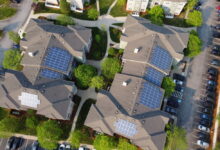Most homeowners can decide for themselves whether to install rooftop solar panels. But for the millions of Americans living in apartments or condominiums, options may seem limited. Multi-unit buildings often have large, shared roofs ideal for solar, but legal complexities and split incentives exist.
Community Solar Programs
The experts at Vivint Solar say that one approach to solar for multi-unit properties is community solar farms rather than on-site solar panels. Through a community solar program, households subscribe to a portion of a larger shared solar installation located remotely. The utility credits subscribers for their share of the energy produced based on usage.
Community solar expands renewable energy access to renters, condo owners and other residents lacking space for their own panels. The third-party manager handles maintenance, while subscribers benefit from credit on their electricity bills. But the power is not used directly on-site, as with rooftop solar.
Shared Solar Systems on Multi-Unit Buildings
Local laws may prohibit or limit solar panels owned by individual residents within multi-unit properties. But shared building-wide solar systems are an option. The building owner or homeowners’ association can contract installation of panels to cover the entire roof. Costs get divided among all residents.
With shared systems, installation, maintenance, and solar benefits are managed collectively. Legal agreements outline how to allocate monthly credits on each unit’s utility bills and who will foot repair costs if issues arise. Shared systems maximize roof space compared to each owner, adding separate panels.
Split Incentives Hinder On-Site Shared Solar
The biggest obstacle to shared solar for apartments and condos is the split incentive between owners and tenants. Building owners may be reluctant to front the installation costs if electricity savings go primarily to tenants. Meanwhile, renters have little incentive to contribute to long-term solar investments on units they don’t own.
To get shared solar built, funding models like property-assessed clean energy (PACE) loans can be used. This financing covers the upfront costs, paid back via building property taxes over up to 20 years. The building owner takes the loan, while residents ultimately fund repayment via their rent or condo dues.
Strategies to Overcome Challenges
Several methods help address the challenges of split incentives and upfront costs that hinder multi-unit solar projects:
- Creative power purchase agreements can credit both owner and tenants part of the energy savings.
- Bulk purchasing by housing cooperatives or resident groups lowers install costs.
- Government and utility incentives can discount multi-unit solar costs to spur adoption.
- Non-profit organizations provide development and financing assistance.
- Performance guarantees on energy production assure owners of long-term savings.
Putting Solar on Affordable Housing
Lower income residents have the most to gain from lower utility bills through solar power. Recognizing this, governments, utilities, and housing agencies make extra efforts to add solar capabilities to affordable apartments, public housing, and community projects.
These initiatives take advantage of tax credits, incentives and foundation/donor funding tailored to enable solar for multi-unit buildings that house lower-income families. Shared access to clean energy reduces utility burdens while making housing more sustainable.
Rooftop Space Holds Potential
The large flat roofs of apartment and condo complexes offer prime real estate for potentially massive solar arrays. Just one mid-size building could support hundreds of panels generating a quarter million kilowatt-hours or more of annual solar energy.
Conclusion
With thoughtful partnerships, creative financing and equitable allocation of benefits, this potential can be unlocked to provide all residents access to affordable solar power. The solutions expand renewable energy beyond single-family homes to the millions lacking adequate options to utilize the sun overhead.



